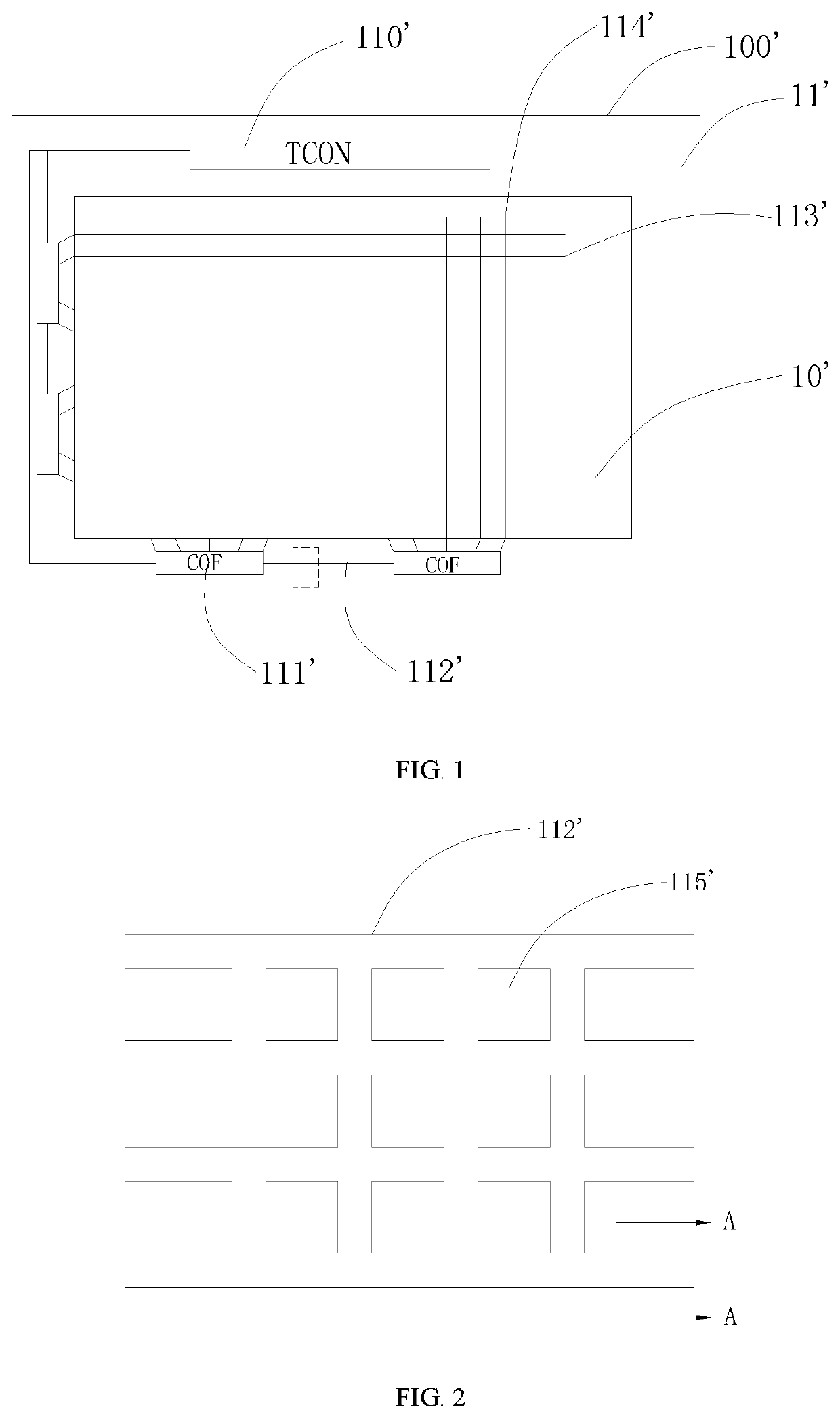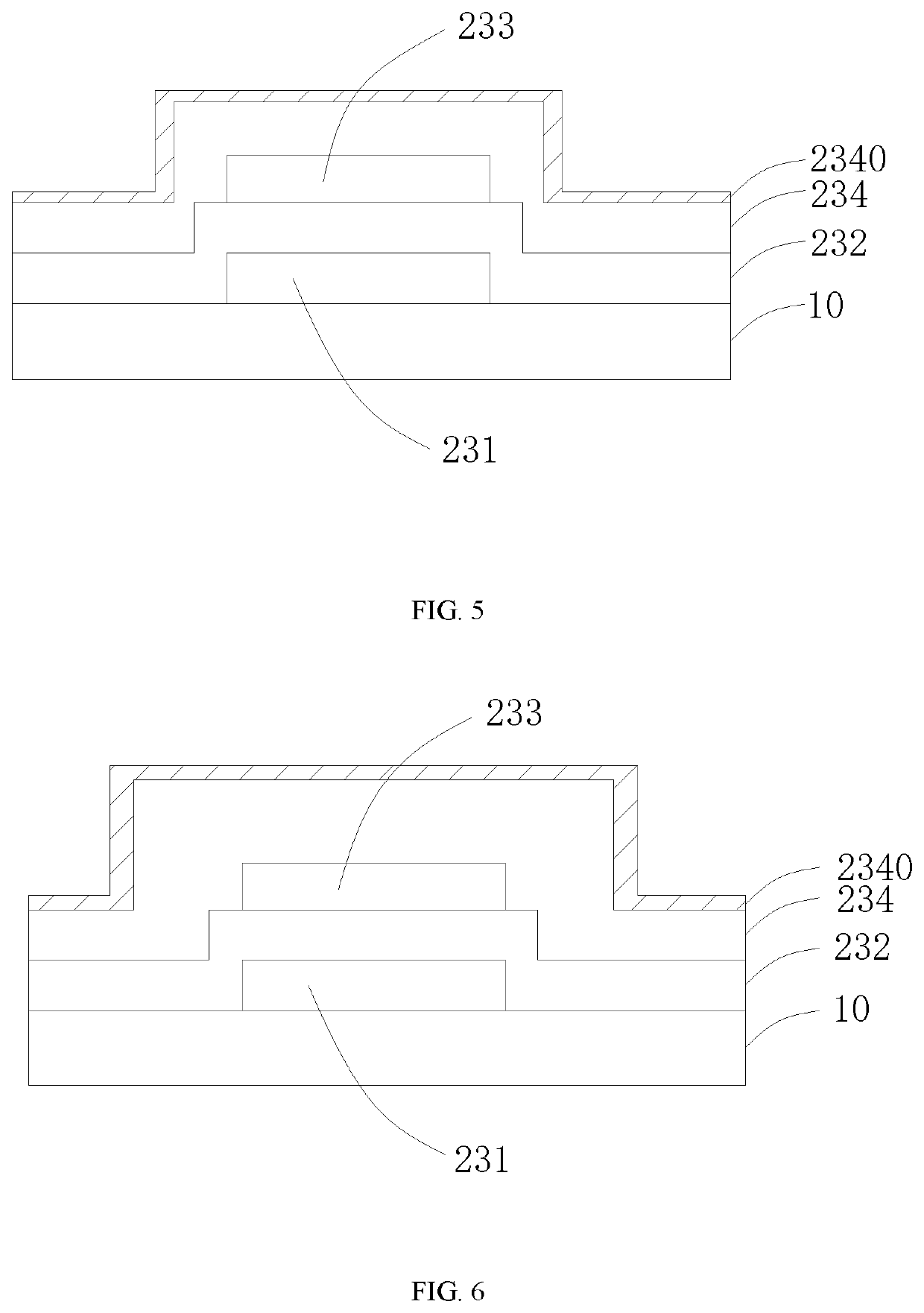Array substrate, display panel, and display
a technology of array substrate and display panel, applied in the field of array substrate, can solve problems affecting the display quality of the panel, and achieve the effects of ensuring the display effect of the display area of the array substrate, preventing the chip-on-film connection line of the non-display area from being corroded, and preventing further penetration of water vapor into the display area
- Summary
- Abstract
- Description
- Claims
- Application Information
AI Technical Summary
Benefits of technology
Problems solved by technology
Method used
Image
Examples
first embodiment
[0051]In the present application, as shown in FIG. 5, the passivation layer 234 is made from an inorganic material of silicon oxide (SiOx) or silicon nitride (SiNx), and the passivation layer 234 has a thickness of 200-230 nm. In particular, the passivation layer 234 is treated with fluoride ions to form a hydrophobic layer 2340 on a surface of the passivation layer 234. Specific steps are as follows: ionizing a gas mixture obtained by mixing CF4 or SF6 with O2, performing dry etching on the surface of the passivation layer 234 of the inorganic material by an ionized gas mixture, and forming hydrophobic groups on the surface of the passivation layer 234 to obtain the hydrophobic layer 2340.
[0052]For the display area 1, a gate and the scan lines 11 are formed on the substrate base layer 10, a gate insulating layer is formed on the gate and the scan lines, an active layer is formed on the gate insulating layer, a source / drain and the data lines 12 are formed on the active layer, the g...
second embodiment
[0055]In the second embodiment, the thickness of the passivation layer 234 in the non-display area 2 is greater than that of the passivation layer on the TFT within the display area 1. In this case, after a passivation layer having a thickness of greater than 230 nm is formed by one time chemical vapor deposition, a portion of the passivation layer on the TFT within the display area can be removed. Thus, not only is the thickness of the passivation layer 234 of the chip-on-film connection line 23 maintained greater than 230 nm, but also the passivation layer on the TFT within the display area 1 is maintained at 200-230 nm.
third embodiment
[0056]In the present application, as illustrated in FIG. 7, the passivation layer 234 comprises a first sub-passivation layer 2341 disposed on the second metal layer 233 and a second sub-passivation layer 2234 disposed on the first sub-passivation layer 2341. A hydrophobic layer 2340 is formed on the surface of the second sub-passivation layer 2342. The sum of the thicknesses of the first sub-passivation layer 2341 and the second sub-passivation layer 2342 is greater than 230 nm.
[0057]In particular, the first sub-passivation layer 2341 has a thickness of 200-230 nm, and the second sub-passivation layer 2342 has a thickness of smaller than 230 nm, for example, smaller than 70 nm, 70-170 nm, or alternatively, 170-230 nm, and the thickness of the passivation layer 234 is 230-460 nm.
[0058]Optionally, the first passivation layer 2341 is made from an inorganic material of silicon oxide (SiOx) or silicon nitride (SiNx), and the second passivation layer 2342 is made from an organic material...
PUM
| Property | Measurement | Unit |
|---|---|---|
| thickness | aaaaa | aaaaa |
| thickness | aaaaa | aaaaa |
| thickness | aaaaa | aaaaa |
Abstract
Description
Claims
Application Information
 Login to View More
Login to View More - R&D
- Intellectual Property
- Life Sciences
- Materials
- Tech Scout
- Unparalleled Data Quality
- Higher Quality Content
- 60% Fewer Hallucinations
Browse by: Latest US Patents, China's latest patents, Technical Efficacy Thesaurus, Application Domain, Technology Topic, Popular Technical Reports.
© 2025 PatSnap. All rights reserved.Legal|Privacy policy|Modern Slavery Act Transparency Statement|Sitemap|About US| Contact US: help@patsnap.com



